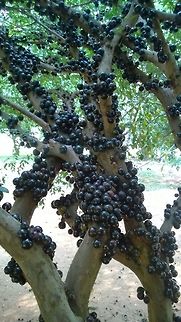
Cultural
The name jabuticaba, derived from the Tupi word ''Jabuti'' + ''Caba'' , meaning the place where you find tortoises. The Guarani name is "Yvapurũ", where ''yva'' means fruit, and the onomatopoeic word ''purũ'' for the crunching sound the fruit produces when bitten.A traditional song from the eastern region of Bolivia refers to a young woman as having "eyes like the guapuru" and a mouth "as sweet as the achachairu."
The jabuticaba tree, which appears as a charge on the coat of arms of Contagem, Minas Gerais, Brazil, has become a widely used species in the art of bonsai, particularly in Taiwan and parts of the Caribbean.
In Brazil, it is common to refer to something allegedly unique to the country as a "jabuticaba" since the tree supposedly only grows in Brazil. It is usually a pejorative expression.
References:
Some text fragments are auto parsed from Wikipedia.